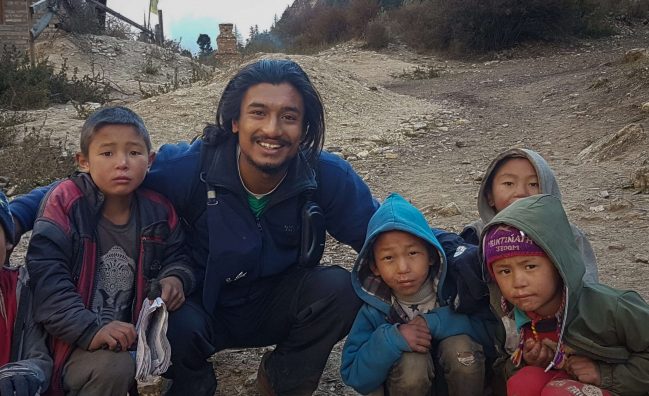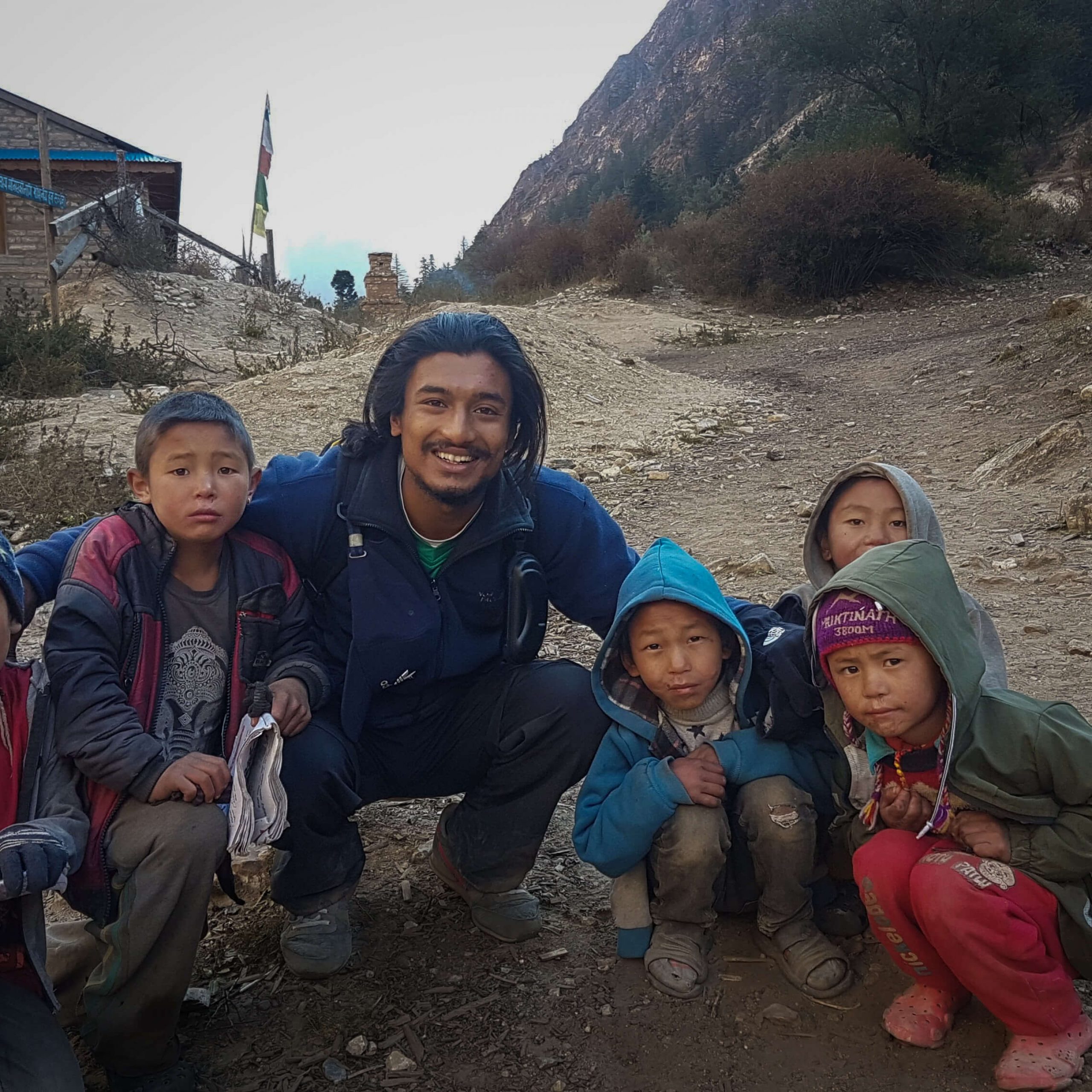Lying at an altitude of 4580m between the mountain ranges of Langtang and the Everest region, Tsho Rolpa lake is one of the biggest glacial lakes of Nepal. Located in the Rolwaling Valley of Dolakha, this glacial lake gets a smaller number of tourists compared to neighboring regions making it a perfect destination to enjoy natural serenity peacefully. Starting with a bus ride from Kathmandu to Chetchet, you will then walk past picturesque villages like Simigaun, Donang, Beding, and Na before reaching a milky white colored glacial lake surrounded by stunning Rolwaling mountains. Witness fluttering prayer flags, monasteries, gompas, long suspension bridges, huge waterfalls, fast-flowing rivers, rhododendron forests, abandoned villages and stunning views of mountains such as Gauri Shankar (7145m), Dorje Lakpa, Melungtse (7171m) and other small peaks during this whole trek. As it falls on the Tibet border side, this region is mostly inhabited by Buddhist people but you will also come across Brahmin and Chhetri people also.
8 days 7 nights
Specific Tour
___
25 people


Drive from Kathmandu (1400m) to Chetchet Dolakha (9-10 hrs drive) (1398M) Trek to Simi gaun ( 3 Hrs hike)
Our trek to the divine Tsho Rolpa lake in Rolwaling valley starts at 5 Am with a drive to the beautiful district called Dolakha. Throughout our long journey, we are constantly blessed with the views of picturesque villages, amazing mountain ranges, local bazaars, terraced green fields and hills far away. After arriving at Chetchet which is the starting point of our trek, we hike towards Simigaun, our destination for tonight. It takes nearly 3 hours to reach Simi Gau from Chet Chet as our way is an uphill climb full of numerous stone stairs. Situated at an elevation of 2,000 meter from sea level, Simigaun is a picturesque and green terraced village full of hospitable locals. Overnight stay at a lodge in Simigaun.
After our breakfast in Simigaun, we start our trek towards Dongang village which is situated at the bank of the Rolwaling river. Our trail today is filled with numerous stone stairs and requires lots of ascend and descend. We walk slowly and comfortably while taking a rest through dense forest along the Rolwaling River. On our path we get to see numerous waterfalls, small wooden bridges, long suspension bridges and small settlements like Surmuche and Kyalche with only one or two houses in between. Dongang, our stop for today, is a stop with only 2 hotels. We enjoy our evening relaxing in the riverside and exploring the surrounding. Overnight stay at a lodge in Dongang.
Today after a healthy breakfast at the beautiful riverside Dongang lodge, we start our trek to Beding village. Bedding is a beautiful village and has the largest settlements among the Rolwaling region. Our trail today is extremely pleasing as we pass through the sides of scenic Rolwaling river, dense rhododendron forest, suspension bridges and majestic waterfalls while looking at the breathtaking view of snowcapped Gaurishankar mountain in front of us. After reaching Thanding, our trail becomes comfortable with less stone stairs and a straight path. After reaching Beding village, we spend our evening exploring and roaming around as this village is extremely scenic and picturesque with beautiful surrounding landscapes. Overnight stay at a lodge in Beding.
We will wake up early in the morning. After having breakfast we will go for Jogini waterfall trek which is totally optional. If
you don’t want to go for trek you can spend your time at Manali Market
At jogini waterfall you can enjoy packed lunch with beautiful mountains and
waterfall. You can capture the beautiful moments and make the memories with your
loved ones. After completing trek we will go for local sightseeing of Manali
which includes Hadimba devi Temple, Vashishth Temple (Hot spring), old manali and Manali Market. After lots of
shopping and memories we will return to the camp and have delicious dinner.
Food Plan :- Breakfast,Pack Lunch & Dinner
Night Stay :- Manali Campsite
Our fifth day starts with munching breakfast while looking at the beautiful Beding and then getting ready to hike towards Na Gaun. Today’s trek is short and easy compared to previous days so we can also hike around the monasteries and Gumba of Beding before going to Na Gaun. After exploration, we head out towards Na Gau which takes about 3 hours. We walk slowly and comfortably on trails which are full of chortens, prayer flags and stone stairs until we reach a beautiful plain valley covered with grasslands. Beautiful views of Gaurishankar and other mountains follow us throughout our journey to Na Gaun. View from Na Gaon is nestled at the foot of a huge series of hills and mountains so we spend our evening watching the surrounding landscapes. Overnight stay at a lodge in Na Gaon.
This is the day we have been waiting for so long as we make a final hike from Na Gaon to reach the divine Dudh kunda and Tsho Rolpa Lake at 4580m. We wake up early in the morning, munch our breakfast looking at the view and then start hiking. Way to Dudh kunda and Tsho Rolpa lake from Na village is quite easy but due to increase in altitude, we may face some difficulties and to avoid that we walk slowly and steadily. Our path is filled with stunning views of mountain ranges, small glaciers and snow-covered hills on all sides. After making an effort of ascending a rocky hill, we finally reach (Dudhkunda means milky lake in Nepali). After that our journey will be upto Tsho Rolpa Lake which will take around 1 and half hour from Dudh kunda lake.We spend our precious time roaming around and exploring the glorious lake and the magical surroundings. After capturing the overwhelming beauty of Tsho Rolpa glacial lake and making life long memories, we retrace our way back to Naa Gaun and Overnight stay at a lodge in Na.
Today we hike back from Beding to Dongang through the same way we came up a few days ago. After breakfast in Beding, we again walk along the sides of the beautiful Rolwaling river while looking back at the views of Gaurishankar from time to time. After descending for a few hours, we come across a suspension bridge. We cross the bridge and walk for a few hours in a dense forest to reach Dongang situated on the banks of the river. Overnight stay at a lodge in Dongang.
After our breakfast today, we return back to Simi Gau, retracing the same beautiful trails. We walk along the dense forest witnessing various waterfalls and rhododendron trees. Our hike today is much easier as we descend from stone stairs most of the time. But there is a possibility of small accidents while descending so we take our time and walk slowly and carefully. After reaching Simi Gau, we enjoy the cool evening breeze while looking at the village beauty. Overnight stay at a lodge in Simigaun.
Today is our last day of trekking as we hike down early morning from Simigaun to Chetchet and then drive back to Charikot, Dolakha. Bus leaves for Kathmandu at 5am and 6am there is no bus afterward so we have to wake up early and walk to chetchet After breakfast in Simigaun, we start descending from the numerous stone stairs carefully until we reach a suspension brigade. After crossing the long bridge, we finally reach Chet Chet from where we drive back to Kathmandu. Drive to Kathmandu is full of natural scenery local food and local settlements on the way.